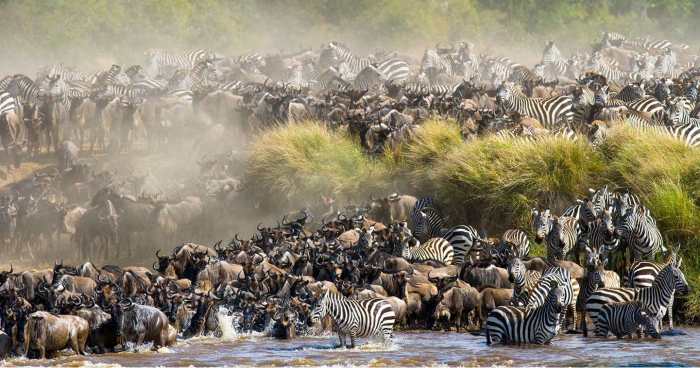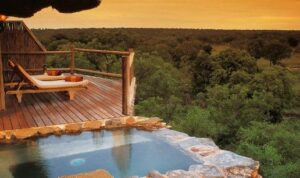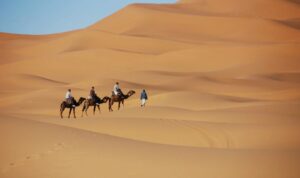Masai Mara Migration, a spectacle of nature that unfolds across the vast plains of Kenya, is a testament to the power of instinct and the delicate balance of life. This annual movement of millions of wildebeest and zebra is a breathtaking display of raw survival, where the very essence of the ecosystem is put on full display.
The Masai Mara ecosystem, a vibrant tapestry of grasslands, forests, and rivers, provides the perfect stage for this epic journey. The migration is a vital part of the ecosystem’s health, influencing the flow of nutrients and the dynamics of predator-prey relationships. But the migration is not without its challenges, as habitat loss and human encroachment threaten the very existence of this natural wonder.
The Masai Mara Ecosystem

The Masai Mara National Reserve, renowned for its annual wildebeest migration, is a haven of biodiversity and a testament to the delicate balance of nature. This ecosystem, nestled in the heart of Kenya, is characterized by its sprawling grasslands, acacia woodlands, and meandering rivers, providing a perfect habitat for a wide array of plant and animal life.
The Role of Diverse Plant and Animal Life
The Masai Mara’s diverse plant and animal life play a crucial role in supporting the migration. The vast grasslands, dotted with acacia trees, provide sustenance for millions of herbivores, including wildebeest, zebra, and gazelle. The presence of these herbivores, in turn, attracts predators such as lions, leopards, and cheetahs, creating a complex food web that sustains the ecosystem.
Challenges Facing the Masai Mara Ecosystem
The Masai Mara ecosystem faces numerous challenges, including habitat loss and human encroachment.
- Habitat Loss: The increasing demand for land for agriculture and human settlements is leading to the fragmentation and degradation of the ecosystem. This poses a threat to the migration routes and the overall health of the ecosystem.
- Human Encroachment: The growing human population in the region puts pressure on the ecosystem’s resources. Overgrazing by livestock and poaching threaten the delicate balance of the food web and can disrupt the migration patterns.
The Migration Route

The annual migration of wildebeest and zebra across the Masai Mara is a spectacle of nature, a journey driven by the relentless cycle of rain and the search for fresh grazing lands. The route they take is a testament to the intricate balance between the needs of these animals and the changing conditions of their environment.
The migration is not a rigid, fixed path but rather a fluid movement influenced by several factors. Rainfall patterns, the availability of fresh grass, and the presence of predators all play a role in determining the direction and timing of the migration.
Seasonal Variations in the Migration Route
The migration route changes significantly between the wet and dry seasons. During the wet season (March to May), the herds are concentrated in the southern part of the Masai Mara, where the rains have produced lush, green pastures. As the dry season sets in (June to October), the herds begin their journey north, following the receding rains and seeking out fresh grazing lands in the northern areas of the Masai Mara and the Serengeti National Park in Tanzania. The dry season marks the peak of the migration, with millions of animals moving across the plains, a sight that draws visitors from all over the world.
The Masai Mara Migration is a breathtaking spectacle of nature, with millions of wildebeest and zebra traversing the vast plains in search of greener pastures. While the migration is a testament to the raw power of the natural world, the captivating stories of South African cinema also showcase the strength and resilience of the human spirit. To delve deeper into the captivating world of South African cinema, explore the Meet The Hottest Leading Men In South African Cinema 2024 article, where you can discover the talented actors who bring these stories to life.
Returning to the Masai Mara, the migration is a powerful reminder of the interconnectedness of all living things and the awe-inspiring beauty of our planet.
The migration route is a continuous cycle, with the herds returning to the southern part of the Masai Mara during the wet season, completing the circle of life and survival.
The Masai Mara Migration is a breathtaking spectacle of nature, with millions of wildebeest and zebra traversing the vast plains of Kenya in search of greener pastures. To truly understand the scale and drama of this event, you might want to explore some of the Top African Tv Shows You Can’ which capture the raw beauty and danger of the migration.
From the iconic “The Serengeti” to lesser-known documentaries, these shows offer a window into the lives of these animals and the challenges they face, enriching your understanding of the Masai Mara Migration.
The Wildebeest and Zebra Herds

The Masai Mara’s iconic migration is driven by the movement of millions of wildebeest and zebra, their synchronized journey a testament to the power of instinct and the delicate balance of the ecosystem.
Population Size and Behavior
The wildebeest and zebra herds are the heart of the migration, with their numbers fluctuating annually. The wildebeest population typically ranges between 1.3 and 1.5 million, while the zebra population hovers around 300,000. These animals are highly social, traveling in vast herds for safety and to access resources. Wildebeest, known for their distinctive long horns and powerful bodies, are grazers, consuming large quantities of grass. Zebras, with their distinctive black and white stripes, are also grazers, but their diet includes a wider variety of vegetation.
Reasons for Movement
The migration is driven by the search for fresh grazing lands and water. The herds follow the rains, seeking lush pastures that regenerate after the dry season. The annual cycle begins in the Serengeti National Park in Tanzania, where the herds calve during the wet season. As the dry season sets in, the herds move north towards the Masai Mara in Kenya, drawn by the greener pastures and the abundance of water.
Challenges During the Migration
The journey is not without its challenges. The herds face threats from predators, disease, and harsh weather conditions. The crossing of the Mara River, often swollen and turbulent, is a particularly perilous moment, with many animals succumbing to the strong currents and lurking crocodiles. The herds also face challenges from human activities, such as poaching and habitat fragmentation.
Role of Predators, Masai Mara Migration
Predators play a crucial role in shaping the migration dynamics. Lions, leopards, cheetahs, hyenas, and crocodiles all prey on the wildebeest and zebra, influencing their movement and behavior. The presence of predators keeps the herds moving, preventing overgrazing in specific areas and maintaining the delicate balance of the ecosystem. The predators also play a role in regulating the population of the wildebeest and zebra, ensuring that their numbers remain sustainable.
The Impact of the Migration: Masai Mara Migration

The Masai Mara migration is not merely a spectacle of nature; it is a force that shapes the ecosystem and the lives of those who depend on it. Its impact extends far beyond the spectacle of millions of animals on the move, influencing the economy, ecology, and conservation efforts in the region.
Economic Impact
The migration is a cornerstone of the Kenyan economy, particularly in the Masai Mara region. The influx of tourists drawn to witness this natural phenomenon generates significant revenue through tourism activities.
- Tourism Revenue: The Masai Mara National Reserve, a key destination for witnessing the migration, receives a substantial portion of its income from tourism fees, lodge bookings, and related services.
- Employment Opportunities: The tourism industry creates numerous employment opportunities for local communities, ranging from lodge staff and tour guides to souvenir vendors and transportation providers.
- Community Development: The revenue generated by tourism often contributes to community development projects, such as schools, healthcare facilities, and infrastructure improvements, benefiting the local population.
Ecological Impact
The migration’s ecological impact is multifaceted, influencing the environment and the interactions between various species.
- Nutrient Cycling: The movement of vast herds across the landscape plays a vital role in nutrient cycling. Their grazing and dung deposition fertilize the soil, contributing to the richness of the ecosystem.
- Vegetation Dynamics: The migration’s grazing patterns influence the vegetation dynamics of the Masai Mara. Their consumption of grasses and other vegetation helps maintain the open grasslands and prevents the encroachment of woody plants.
- Predator-Prey Interactions: The migration creates a dynamic predator-prey relationship. The presence of millions of wildebeest and zebra attracts large predators like lions, cheetahs, and hyenas, influencing their population dynamics and hunting strategies.
Conservation Challenges and Opportunities
While the migration brings significant benefits, it also presents challenges for conservation efforts.
- Habitat Loss and Fragmentation: Human encroachment, including agriculture and settlement, threatens the migration’s habitat, leading to fragmentation and reducing the area available for the herds.
- Poaching and Illegal Activities: Poaching and other illegal activities pose a threat to the migration’s wildlife population, particularly targeting predators that rely on the herds for sustenance.
- Climate Change: Climate change impacts the migration’s route and timing, affecting the availability of resources and potentially disrupting the natural cycle.
The Human Connection

The Masai Mara migration is not just a spectacle of nature; it’s deeply intertwined with the lives of the Maasai people, who have lived in this region for centuries. The migration’s rhythm has shaped their culture, traditions, and livelihood, creating a unique bond between humans and wildlife.
Cultural Significance
The Maasai culture is deeply rooted in the land and its inhabitants. The migration is an integral part of their history, influencing their beliefs, rituals, and social structure. The vast herds are seen as a symbol of abundance and prosperity, providing sustenance and resources for the Maasai.
- Cattle herding: The Maasai are renowned for their cattle herding practices, which are closely linked to the migration. The wildebeest and zebra provide a valuable resource for the Maasai, as they often graze in the same areas, leading to competition for pasture. This competition has shaped the Maasai’s understanding of land use and resource management.
- Spiritual connection: The migration is often seen as a spiritual event, reflecting the Maasai’s belief in the interconnectedness of all living things. The Maasai believe that the spirits of their ancestors reside in the land and that the migration is a sacred journey, connecting them to their past and their future.
- Cultural ceremonies: The migration is also associated with various cultural ceremonies and rituals, such as the “Eunoto” ceremony, which marks the transition of young men into adulthood. The migration is a time of celebration and renewal for the Maasai, reinforcing their cultural identity and traditions.
Coexistence Challenges and Opportunities
The coexistence between the Maasai and the migrating herds is a complex and dynamic relationship. While the migration provides benefits, it also presents challenges for the Maasai.
- Competition for resources: The migrating herds can cause significant damage to Maasai grazing land, reducing the availability of pasture for their cattle. This competition for resources can lead to conflict between the Maasai and wildlife conservationists.
- Disease transmission: The proximity of the migrating herds can increase the risk of disease transmission to Maasai livestock. Diseases such as anthrax and foot-and-mouth disease can have devastating consequences for the Maasai economy.
- Tourism impact: The growing tourism industry associated with the migration can also have unintended consequences for the Maasai. While tourism generates income, it can also lead to cultural disruption and environmental degradation.
Despite these challenges, there are also opportunities for coexistence. The Maasai are increasingly involved in conservation efforts, recognizing the importance of protecting the migration for their own well-being and the future of the ecosystem.
Conservation Efforts
The Maasai have a long history of conservation, viewing the land and its wildlife as sacred and essential for their survival. In recent years, they have partnered with conservation organizations and government agencies to protect the migration and the surrounding ecosystem.
- Community conservancies: The establishment of community conservancies has empowered the Maasai to manage their own land and resources. These conservancies promote sustainable tourism, wildlife conservation, and community development, fostering a sense of ownership and responsibility among the Maasai.
- Wildlife monitoring: The Maasai are actively involved in monitoring wildlife populations, providing valuable data for conservation efforts. They also play a crucial role in protecting wildlife from poaching and other threats.
- Ecotourism: The Maasai are increasingly embracing ecotourism, which promotes sustainable tourism practices and benefits local communities. This approach recognizes the importance of cultural preservation and environmental protection.
The Masai Mara Migration is a story of resilience, adaptation, and the delicate balance of life. It is a reminder of the interconnectedness of all living things and the importance of conservation efforts in preserving this natural treasure. The migration’s impact on the ecosystem, the local communities, and the global tourism industry is profound, making it a critical focus for conservationists and policymakers alike. As we continue to witness this extraordinary spectacle, let us remember our responsibility to protect this magnificent natural phenomenon for generations to come.







